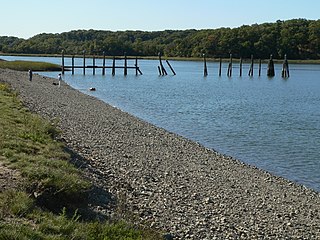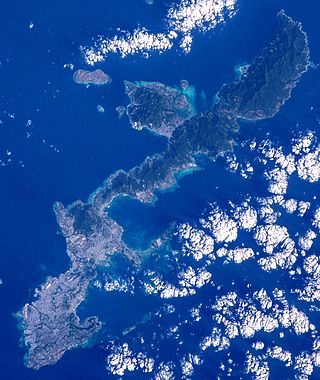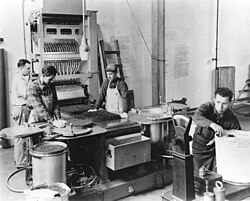
Hawthorne Army Depot (HWAD) is a U.S. Army Joint Munitions Command ammunition storage depot located near the town of Hawthorne in western Nevada in the United States. It is directly south of Walker Lake. The depot covers 147,000 acres (59,000 ha) or 226 sq. mi. and has 600,000 square feet (56,000 m2) storage space in 2,427 bunkers. HWAD is the "World's Largest Depot". It is divided into three ammunition storage and production areas, plus an industrial area housing command headquarters, facilities, engineering shops, etc.
The Picatinny Arsenal is an American military research and manufacturing facility located on 6,400 acres (26 km2) of land in Jefferson and Rockaway Township in Morris County, New Jersey, United States, encompassing Picatinny Lake and Lake Denmark. The Arsenal is the headquarters of the US Army Combat Capabilities Development Command Armaments Center. It is known for developing the ubiquitous Picatinny rail, as well as being the Army's center of expertise for small arms cartridge ammunition.

The Royal Navy Propellant Factory, Caerwent was a facility at Caerwent, Monmouthshire, Wales, UK, which was originally dedicated to the manufacture and storage of Royal Naval munitions. Since its closure as an armament works in 1966, it has been used by the US military and the British Army. It is now used as the Caerwent Training Area. A new purpose-built military barracks is set to be built on the site to house 1st The Queen's Dragoon Guards and 1st Battalion, The Rifles from 2027.
Canadian Forces Detachment Dundurn is a Canadian Forces facility located near the town of Dundurn, Saskatchewan and approximately 40 km south of Saskatoon, Saskatchewan along the east bank of Brightwater Creek.

Wompatuck State Park is a state-owned, public recreation area of about 3,500 acres (1,400 ha) in size located primarily in the town of Hingham with portions in the neighboring towns of Cohasset, Norwell, and Scituate, Massachusetts, in the United States. In addition to a large campground and an extensive trail system, the park is noted for the free spring water that can be obtained at Mt. Blue Spring, which has been in operation since the mid-19th century. The park is managed by the Massachusetts Department of Conservation and Recreation which protects forests of the northeastern coastal forests ecoregion.
The Defence Explosive Ordnance Disposal, Munitions and Search Training Regiment is an element of the Royal School of Military Engineering responsible for the delivery of training to British Army Ammunition Technicians, Ammunition Technical Officers and Search Operators. The Regiment delivers training from two locations: Marlborough Barracks, MoD Kineton near Kineton, Warwickshire and St George's Barracks, MoD Bicester, near Bicester, Oxfordshire.
The Naval Ammunition Depot Hastings near Hastings, Nebraska was the largest United States World War II naval munitions plant operating from 1942 to 1946 and produced over 40% of the U.S. Navy's munitions.
The Hingham Naval Ammunition Depot Annex, sometimes called the “Cohasset Annex” or "Hingham Annex" by local residents, covered sections of the towns of Hingham, Cohasset, Norwell, and Scituate Massachusetts. It served as an annex to the Hingham Naval Ammunition Depot.

Camp Wellfleet is a former United States military training camp. It occupies about 1,738 acres (7.03 km2) of land located along the Atlantic Ocean in the town of Wellfleet, Massachusetts on Cape Cod. The 548th Antiaircraft Artillery Battalion used the Camp for a firing range from 1954-1956. The majority of the site is owned and maintained by the National Park Service, as the administrator of the Cape Cod National Seashore. The Town of Wellfleet owns a portion of the site. It was officially opened on March 19, 1943.
Camp Calvin B. Matthews or Marine Corps Rifle Range Camp Matthews or Marine Corps Rifle Range, La Jolla or more simply Camp Matthews was a United States Marine Corps military base from 1917 until 1964, when the base was decommissioned and transferred to the University of California to be part of the new University of California, San Diego (UCSD) campus. Over a million Marine recruits as well as other shooters received their marksmanship training at this military base.
Supply depots are a type of military installation used by militaries to store battlefield supplies temporarily on or near the front lines until they can be distributed to military units. Supply depots are responsible for nearly all other types of materiel, except ammunition.

Naval Support Activity Charleston, originally designated Naval Weapons Station Charleston, is a base of the United States Navy located on the west bank of the Cooper River, in the cities of Goose Creek and Hanahan South Carolina. The base encompasses more than 17,000 acres (69 km²) of land with 10,000 acres (40 km²) of forest and wetlands, 16-plus miles of waterfront, four deep-water piers, 38.2 miles (61.5 km) of railroad and 292 miles (470 km) of road. The current workforce numbers more than 11,000 with an additional 3,600 people in on-base family housing.

US Navy 7 Naval Ammunition Depot was located at Springhill, near Northam, Western Australia. It was one of three US Naval Ammunition Depots developed across Australia during World War II to support the service's operations in the South West Pacific.
YF-415 was a covered lighter in service with the United States Navy during World War II. It was accidentally sunk on May 11, 1944 while disposing of surplus explosive ordnance near Boston Harbor.

Bare Cove Park is a 484 acre park designated for wildlife and public recreation. It is located in Hingham, Massachusetts, on the Weymouth Back River across from Great Esker Park.

Naval Advance Base Espiritu Santo or Naval Base Espiritu Santo, most often just called Espiritu Santo, was a major advance Naval base that the U.S. Navy Seabees built during World War II to support the Allied effort in the Pacific. The base was located on the island of Espiritu Santo in the New Hebrides, now Vanuatu, in the South Pacific. The base also supported the U.S. Army and Army Air Corps, U.S. Coast Guard, and US Marine Corps. It was the first large advance base built in the Pacific. By the end of the war it had become the second-largest base in the theater. To keep ships tactically available there was a demand for bases that could repair and resupply the fleet at advance locations, rather than return them to the United States. Prior to December 7th, Pearl Harbor was the U.S. fleet's largest advance base in the Pacific. Espiritu became capable of all aspects necessary to support the Fleet's operations from fleet logistics in fuel, food, and ammunition, to transport embarkation for combat operations or returning to the continental United States. The ship repair facilities and drydocks were capable of attending to most damage and routine maintenance. Had it not existed, ships would have had to return to Pearl Harbor, Brisbane, or Sydney for major repairs and resupply. The base became a major R and R destination for the fleet.

Naval Base Okinawa, now Naval Facility Okinawa, is a number of bases built after the Battle of Okinawa by United States Navy on the Okinawa Island of Japan. The naval bases were built to support the landings on Okinawa on April 1, 1945, and the troops fighting on Okinawa. The Navy repaired and did expansion of the airfields on Okinawa. United States Navy Seabees built or repaired the facilities on the island. The bases on Okinawa put the United States Armed Forces only 350 miles from Japan's home islands. Most facilities closed after the war, but some are still in use today in all branches of the United States Armed Forces.










